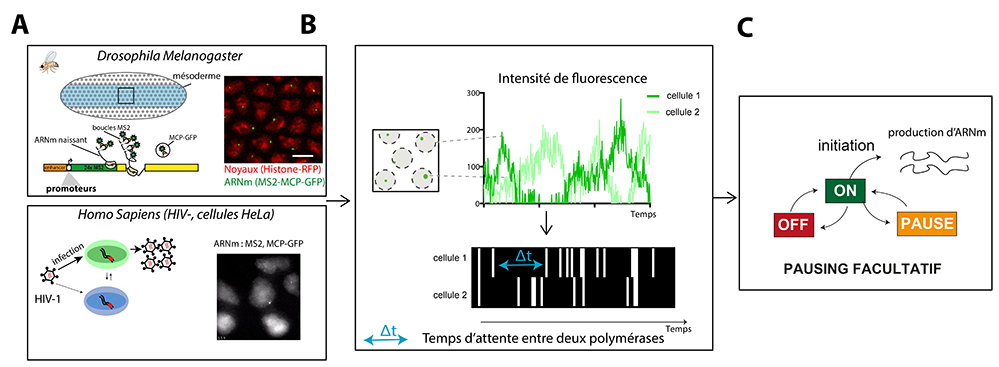Cellular noise: one mechanism, two models
In cells, genetic information is not expressed continuously but intermittently in an stochastic manner. This phenomenon, called transcriptional noise, plays a key role in many situations in biology. It is for instance partly responsible for the rebound in viral loads when anti-HIV therapy is stopped in patients, and it also plays an essential role during embryonic development. In these two articles, published jointly in the journal Nature Communications, the scientists used live cell RNA labeling and innovative mathematical approaches to show that transcriptional noise uses a common mechanism in both HIV-infected cells and Drosophila embryos. This mechanism involves the pause of RNA polymerases near their transcription initiation site.
Drosophila model:
Using Drosophila as a model organism, it is possible to follow RNA synthesis in real time in a living embryo. In these embryos, the zygotic genome is initially silent and gets activated progressively during development. Activation of gene expression takes place discontinuously for different genes, because transcription requires the assembly of many actors whose action is centralized at the level of a particular DNA sequence called a promoter, which is unique to each gene. To determine the contribution of promoter sequences to the dynamics of transcription, the scientists combined genetic manipulations with quantitative imaging to reveal the different states of the promoters and their switching kinetics in vivo.
Thus, researchers were able to demonstrate that “TATA box” promoters, identified by a particular conserved DNA sequence, are active very early and operate via a simple stochastic transition between an inactive state and a permissive (active) state, in which polymerases initiate every ~10 seconds. A second type of promoters, known as “INR motif” promoters (Initiator), becomes active later in development. In this case, an additional inactive state exists, which is associated with the pausing of RNA polymerase near their initiation site. These multiple promoter states switch stochastically at different time scales. In the context of a rapidly developing embryo, this multiscale control contributes to the proper timing and levels of gene expression during the awakening of the zygotic genome.
HIV model:
In patients infected with HIV, it is not currently possible to eliminate the virus and people must follow lifelong antiviral treatments. Eradication of HIV is impossible due to latent forms of the virus, in which an infected cell does not express the viral genome and remains undetectable by the immune system. These latent viruses can occasionally wake up and restart viral propagation, and this produces viral rebounds in patients who stop their antiviral therapy. The mechanisms allowing viral reactivation in latent cells are the subject of intense investigations. One of the mechanisms that limits transcription in latent cells is the arrest of RNA polymerases near the viral promoter. This stop, also called pausing, blocks the initiation of new polymerases and thus inhibits viral expression.
Using a method that visualizes viral RNAs in living cells with single-molecule sensitivity, the scientists analyzed viral transcription under conditions mimicking those of latent cells. Surprisingly, these cells display short pulses of viral transcription separated by long periods of inactivity lasting hours. These pulses are linked to pausing. Indeed, in contrast to what was previously thought, scientists showed that the pause of RNA polymerases near the viral promoter is a stochastic and rare event (1/20 to 1/200 polymerases). Thus, when an arrested polymerase randomly restarts, a whole convoy of new polymerases transcribe the viral genome before a newly-initiating polymerase pauses again. This however produces enough viral components to trigger a new infection cycle.
Mathematics decodes cell noise:
The scientists analyzed these two biological models using the same mathematical method. For each cell, this method reconstructs a complete map of polymerase positions over time (such as an image of all the cars on a highway). Then, it uses exact solutions of what in mathematics is called an "inverse problem", to trace the rates of transition between the molecular states of the promoter and thus to quantify the probability and duration of polymerase pauses.
Thus, by analyzing two different biological systems and using a mathematical processing method "making the invisible visible", the scientists demonstrate that the pauses of RNA polymerases is facultative and stochastic, thus contributing to the intermittency of gene expression.

B-Deconvolution of the fluorescent MCP-GFP signal to determine the timing of transcription initiation events. The fluorescent signal generated from each transcription site consists of several nascent RNAs, produced by several polymerases that each initiated at a time t. In order to determine the precise moments when each polymerase initiates transcription, the researchers implemented an innovative machine learning method.
C-Modeling of kinetic steps limiting transcription. Statistical analysis of the time intervals between transcription initiation events makes it possible to estimate the number of promoter states and to determine which promoter model corresponds to the experimental data. Thus, scientists have demonstrated that some promoters operate by simple regulation between a permissive state and an inactive state, while others promote regulation by three key kinetic steps. This is the case for promoters regulated by polymerase pausing, such as developmental promoters and the HIV promoter. However, the data suggest a new pausing model, in which pausing is not obligatory and occurs only infrequently, for a fractions of the RNA polymerases.